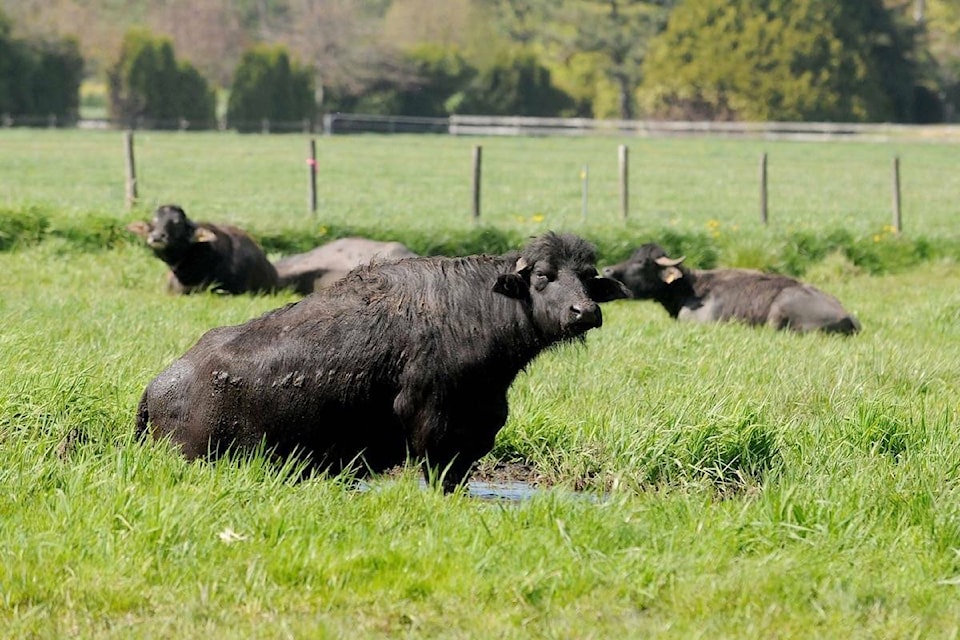It is believed that the first water buffaloes to walk this Earth could be found tranquilly grazing the pastures of the Indian subcontinent.
Domesticated more than 6,000 years ago, these bovids have proven their ability to endure the scorching Southeast Asian heat. This very resilience has made them the preferred choice of cattle for millions of farmers worldwide who utilize them for various purposes, including agricultural labour, meat, and dairy production.
Earning their name for their propensity to lie in mud puddles and stay in shallow waters for countless hours, these black-skinned gentle giants use mud-wallowing as a means of thermoregulating their body temperature.
Along with their owners, these docile beasts travelled and settled down everywhere across Eurasia and Africa. It is said that the first ones to arrive in Canada made their appearance in the early 2000s and came from a Bulgarian herd.
Some of these very descendants are found at McClintock’s Farm located in Vancouver Island’s Comox Valley, and today, this family-run operation is only one of 10 water buffalo dairy farms in the country.
Though the McClintocks have been farming for the last five generations, going all the way back to 1876, the farm was officially established by Val and Jerry McClintock in 1988 and started out as a blueberry farm.
It took more than four decades for the farm to welcome its first buffaloes.
In 2012, their daughter Sandra decided to venture into the uncharted world of water buffalo dairy production.
This career path turned out to be more challenging than she thought.
“At first, I thought maybe I would just milk cows and make ice cream, but all of the different business plans we went through showed that it was a bad idea no matter how we fiddled with the numbers,” said McClintock. “It’s at that time that someone suggested water buffaloes. It was a ridiculous idea, but there were some for sale in Duncan. So we went, bought them, and started from there.”
In March of that same year, after constructing the barn and milking parlour, the McClintocks milked their first cows.
Despite being an accomplished farmer with a degree in agriculture and having worked on numerous dairy and cattle farms in Australia, New Zealand, and Canada, Sandra mentioned that the initial months were harrowing. Much of it had to do with dealing with the animal itself.
“They’re a lot more docile than your regular dairy cow,” said McClintock. “They’re actually really easy to deal with once they trust you, but they have to trust you and that’s a process. Otherwise, they kick like mad and they have this really amazing ability to hold their milk if anything happens that they don’t like. Because we didn’t have this lifelong relationship with the first cows, it was way harder.”
Producing a daily average of 14 litres, water buffalo generate significantly less milk than their North American counterparts, who average 35 litres a day. However, water buffalo outlive Canadian dairy cows by about 15 years.
Despite currently managing a herd of 200 and averaging a yearly production of 110,000 litres, the dairy farmer admits that the marketing component of the business was - and still is - the biggest challenge.
“The thing is that you have to find your goal market and create it,” said McClintock. “Normally the marketing board takes care of that for dairy cows so that dairy farmers don’t ever have to deal with it. But that’s not the case with water buffaloes and that’s a huge part of the business. It requires an enormous amount of time and effort.”
This rare and distinctive product differs in many ways from the cow’s milk found in the grocery store.
“It’s totally white,” said McClintock. “You think cow milk is white until you put it next to buffalo milk and you realize that cow milk looks really yellow.”
Besides this obvious visual difference, buffalo milk showcases an impressive nutrition facts table.
In comparison with cow’s milk, buffalo milk has significantly more phosphorus, calcium, magnesium, and Vitamin A, as well as being fattier and containing more protein.
“It’s a much richer milk and it makes cheese with a different flavour and texture,” explained Natural Pastures Cheese Company operations manager Doug Smith. “The most well-known traditional cheese that’s made with water buffalo milk is the mozzarella. In Italy, true mozzarella is made with water buffalo milk.”
Most notably, the unctuous mozzarella di buffala - which translates to buffalo mozzarella - is perhaps one of the world’s most well-known buffalo milk cheeses. According to Smith, achieving the same creamy outcome would not be possible without this milk.
Besides making mozzarella, Natural Pastures offers a wide array of buffalo milk cheeses including bocconcini, brie, feta, and paneer.
In tandem with the cheesemaker, the McClintocks developed their own brand of buffalo milk yogurt.
Now with selling points all across the province and beyond, she and her family are looking at strategies to grow their market and diversify their products.
Despite a slow start, McClintock is now grateful to reap the fruits of her labour that were sown more than a decade ago.
READ ALSO:



